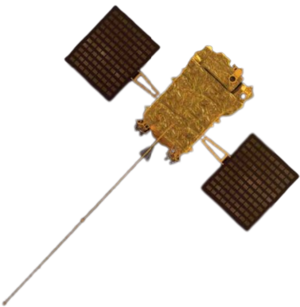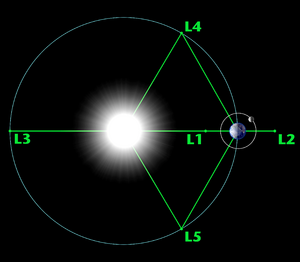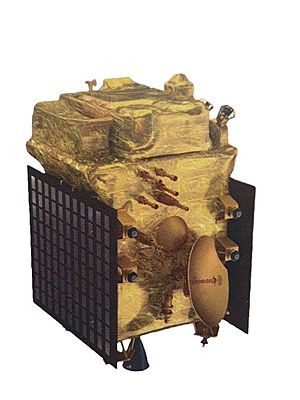Aditya-L1 facts for kids

Aditya-L1 in deployed configuration
|
|
| Mission type | Solar observation |
|---|---|
| Operator | ISRO |
| Mission duration | 5.2 years (planned) 2 years, 3 months and 22 days (elapsed) |
| Spacecraft properties | |
| Bus | I-1K |
| Manufacturer | ISRO / IUCAA / IIA |
| Launch mass | 1,475 kg (3,252 lb) |
| Payload mass | 244 kg (538 lb) |
| Start of mission | |
| Launch date | 2 September 2023, 11:50 IST (06:20 UTC) |
| Rocket | PSLV-XL |
| Launch site | Satish Dhawan Space Centre |
| Contractor | ISRO |
| Orbital parameters | |
| Reference system | Sun–Earth L1 |
| Regime | Halo orbit |
| Period | 177.86 days |
Aditya-L1 is a special spacecraft built to study the Sun. It was designed by the Indian Space Research Organisation (ISRO) and other Indian research groups. This mission is India's first dedicated to observing the Sun.
The spacecraft will travel about 1.5 million kilometers (about 930,000 miles) from Earth. It will settle into a special path called a halo orbit around a spot known as the L1 Lagrange point. From there, it will closely watch the Sun's outer layers, called the solar atmosphere. It will also study solar magnetic storms and how they affect the area around Earth.
Aditya-L1 was launched on September 2, 2023, using a PSLV-XL rocket. This happened just ten days after ISRO's successful Chandrayaan 3 mission landed on the Moon. The spacecraft reached its planned orbit about an hour after launch.
Contents
What Aditya-L1 Will Study
The main goals of the Aditya-L1 mission are to learn more about the Sun. Here are some of the key things it will investigate:
- How the Sun's upper atmosphere (the chromosphere and corona) moves and changes.
- Why the Sun's outer layers get so hot.
- How huge bursts of energy and material, called coronal mass ejections, start.
- What happens in the space around the Sun, like how particles and plasma move.
- How the Sun's magnetic fields are structured.
- What causes space weather, which can affect technology on Earth.
Mission History
The idea for Aditya first came up in 2008. It was originally planned as a smaller satellite, weighing about 400 kg (880 pounds). It would orbit close to Earth to study the solar corona, the Sun's outermost layer.
Later, scientists decided to make the mission much bigger. They wanted it to be a full observatory for the Sun and space environment. Because of this, the mission was renamed "Aditya-L1" and planned to go to the L1 Lagrange point. This new plan allowed it to study the Sun more closely and continuously.
Why the Name Aditya-L1?
The name "Aditya" comes from the Hindu god Surya, who represents the Sun. The "L1" part refers to the Lagrange point 1. This is a special spot between the Sun and Earth where the spacecraft will stay.
How Aditya-L1 Works

The Aditya-L1 mission will take about 109 days to reach its destination. This is a halo orbit around the L1 point, which is about 1.5 million kilometers (930,000 miles) away from Earth. The spacecraft will stay in this orbit for its planned mission time of 5.2 years.
The satellite weighs about 1500 kg (3300 pounds) and carries seven science tools, called payloads. These tools will help scientists understand many things. For example, they will study why the Sun's corona is so hot and how the solar wind speeds up. They will also look at how the Sun's radiation affects Earth's atmosphere and climate.
Aditya-L1 will be able to see different parts of the Sun, including its photosphere, chromosphere, and corona. Some tools will measure energetic particles from the Sun. Another tool, a magnetometer, will measure the strength of the Sun's magnetic field at the L1 point. These measurements are important because they need to be taken far away from Earth's own magnetic field.
One big mystery in solar science is why the Sun's outer atmosphere is super hot (about 1 million degrees Celsius), while its surface is much cooler (about 6,000 degrees Celsius). Scientists also want to know exactly how the Sun's radiation affects Earth's atmosphere and climate. Aditya-L1 will take pictures of different layers of the Sun's atmosphere at the same time. This will help scientists see how energy moves from one layer to another. By doing this, the mission will help us understand the Sun's dynamic processes and solve some of the biggest puzzles in solar physics.
Science Tools (Payloads)
Aditya-L1 has seven science tools, or payloads. Four of these tools will observe the Sun from a distance. The other three will study the local environment at the L1.
Here are the main tools and what they will do:
| TYPE | Tool Name | What it does |
|---|---|---|
| Remote Sensing Tools (look at the Sun from afar) | Visible Emission Line Coronagraph (VELC) | Studies the Sun's corona (outer atmosphere) by taking images and analyzing light. |
| Solar Ultraviolet Imaging Telescope (SUIT) | Takes pictures of the Sun's Photosphere and Chromosphere using ultraviolet light. | |
| Solar Low Energy X-ray Spectrometer (SoLEXS) | Measures soft X-rays from the Sun. | |
| High Energy L1 Orbiting X-ray Spectrometer (HEL1OS) | Measures hard X-rays from the Sun. | |
| In-situ Tools (measure the environment at L1) | Aditya Solar wind Particle Experiment (ASPEX) | Analyzes Solar wind particles, like Protons and heavier ions, and their directions. |
| Plasma Analyser Package For Aditya (PAPA) | Analyzes Solar wind particles, like Electrons and heavier ions, and their directions. | |
| Advanced Tri-axial High Resolution Digital Magnetometers | Measures the magnetic field strength and direction at L1. |
Who Built the Tools?
Different Indian laboratories worked together to build the science tools for Aditya-L1. They also worked closely with various centers of ISRO.
| Tool | Laboratory |
|---|---|
| Visible Emission Line Coronagraph (VELC) | Indian Institute of Astrophysics, Bangalore |
| Solar Ultraviolet Imaging Telescope (SUIT) | Inter University Centre for Astronomy & Astrophysics , Pune |
| Aditya Solar wind Particle Experiment (ASPEX) | Physical Research Laboratory, Ahmedabad |
| Plasma Analyser Package For Aditya (PAPA) | Space Physics Laboratory, Vikram Sarabhai Space Centre, Thiruvananthapuram |
| Solar Low Energy X-ray Spectrometer (SoLEXS) and High Energy L1 Orbiting X-ray Spectrometer (HEL1OS) | U R Rao Satellite Centre, Bangalore |
| Advanced Tri-axial High Resolution Digital Magnetometers | Laboratory for Electro Optics Systems, Bangalore |
Why Aditya-L1 is Important
The Aditya-L1 mission is expected to greatly improve our understanding of the Sun. It will also help us learn how the Sun affects Earth and the space around us. The information gathered could lead to exciting new discoveries in solar physics.
- Solving the Coronal Heating Mystery: One of the biggest puzzles is why the Sun's corona is so much hotter than its surface. Aditya-L1's tools will study the corona in detail. Scientists hope to finally figure out what causes this extreme heating.
- Better Space Weather Forecasts: Understanding the Sun is key to predicting space weather events. These events can harm our technology, like satellites and power grids. Aditya-L1's data will help us understand what causes solar flares and coronal mass ejections. This means we can make better predictions and protect our technology.
- Studying Solar Wind and Magnetic Fields: Tools like ASPEX and the Magnetometer will give us a full picture of the solar wind and the magnetic field in space. This data will help improve models of how the solar wind behaves and how it interacts with Earth's magnetic field.
- Understanding Earth's Climate: The Sun's activity can influence Earth's climate over long periods. Aditya-L1's observations of ultraviolet radiation will help us understand how changes in the Sun might affect Earth's climate patterns.
- Seeing the Sun's Atmosphere Clearly: The mission's tools will observe the Sun's atmosphere from its surface to its outer corona. By watching all these layers at once, scientists can see how energy and material move between them. This will help us understand the Sun's complex behavior.
- Learning About Coronal Mass Ejections (CMEs): CMEs are powerful solar explosions. Aditya-L1 will watch how CMEs start and develop. This will help us understand where they come from and how they behave. This knowledge could lead to better predictions of these potentially disruptive events.
Launch Details
The Aditya-L1 mission was successfully launched on September 2, 2023, at 11:50 a.m. Indian Standard Time (IST). The spacecraft was placed into its planned orbit at about 12:54 p.m. IST on the same day.
The first maneuver to adjust its path around Earth was planned for September 3, at around 11:45 IST.
See Also
 In Spanish: Aditya-L1 para niños
In Spanish: Aditya-L1 para niños
- Solar space missions
- Solar Orbiter
- Parker Solar Probe


